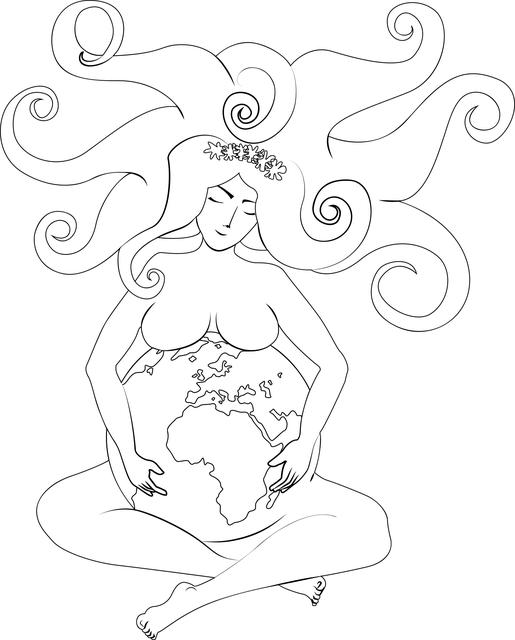Table of Contents
- Understanding the Gaia Hypothesis and Its Impact on Environmental Science
- The Interconnectedness of Life: How the Gaia Hypothesis Shapes Our View of Nature
- Exploring the Evidence: Key Studies Supporting the Gaia Hypothesis
- Practical Implications of the Gaia Hypothesis for Sustainable Living
- Embracing the Gaia Perspective: Recommendations for Individuals and Communities
- Q&A
- Final Thoughts
Understanding the Gaia Hypothesis and Its Impact on Environmental Science
The Gaia Hypothesis, proposed by scientist James Lovelock in the 1970s, suggests that the Earth operates as a single, self-regulating system. This idea is rooted in the interconnectivity of biological and environmental processes, where living organisms interact with their inorganic surroundings to maintain conditions conducive to life. One of the key insights of the hypothesis is the notion that life on Earth contributes to the stability of the ecosystem, regulating the planet’s climate, atmosphere, and even the composition of the oceans.
At its core, the Gaia Hypothesis challenges traditional views of biology and ecology by emphasizing that organisms and their environments are not separate entities, but rather intertwined elements of a larger, dynamic system. This perspective has profound implications for environmental science, as it offers a holistic view of ecological relationships. Here’s how it has impacted various aspects of environmental study:
- Climate Change Mitigation: Understanding the feedback loops within the Gaia system helps scientists develop strategies to combat climate change.
- Biodiversity Conservation: Recognizing the interconnectedness of species underscores the importance of preserving ecosystems.
- Policy Development: Environmental policies informed by Gaia principles advocate for systemic thinking in natural resource management.
Furthermore, the Gaia Hypothesis has catalyzed interdisciplinary research across the fields of biology, geology, and atmospheric science. It promotes a view of the Earth as a complex, adaptive system where even small changes can have significant impacts. The following table summarizes key aspects that illustrate this interconnectedness:
| Element | Function | Impact |
|---|---|---|
| Plants | Carbon dioxide consumption | Regulate atmospheric gases |
| Oceans | Temperature regulation | Influence global climate |
| Microorganisms | Nutrient cycling | Support ecosystem health |

The Interconnectedness of Life: How the Gaia Hypothesis Shapes Our View of Nature
The Gaia Hypothesis offers a revolutionary perspective on our planet, suggesting that life and the environment are part of an intricate, self-regulating system. This framework implies that organisms interact with their inorganic surroundings in a way that maintains conditions favorable for life. By viewing Earth as a singular, living entity, the hypothesis challenges us to reassess our role within this ecosystem, promoting the idea that human activities are not separate from the natural world but intrinsically linked to the health of our planet.
In exploring the principles of interconnectedness, we can identify several key implications of the Gaia Hypothesis:
- Ecological Balance: Every species plays a role in maintaining ecological stability, emphasizing biodiversity’s importance.
- Climate Regulation: Natural processes work in harmony to regulate climate, highlighting the repercussions our actions might have on global systems.
- Ethical Responsibility: This perspective encourages stewardship and sustainable practices, promoting a collective responsibility toward environmental health.
The Gaia Hypothesis also inspires a shift in scientific thinking, urging us to adopt a more holistic approach to environmental science. For instance, it suggests that human-induced changes, such as pollution and deforestation, can destabilize the self-regulating systems of Earth. To illustrate this complexity, consider the following table that outlines various human activities alongside their potential impacts on the environment:
| Human Activities | Potential Environmental Impacts |
|---|---|
| Industrial Pollution | Disruption of air and water quality, harm to wildlife |
| Deforestation | Loss of habitat, decreased biodiversity, carbon emissions |
| Plastic Waste | Ocean pollution, threat to marine life |

Exploring the Evidence: Key Studies Supporting the Gaia Hypothesis
The Gaia Hypothesis, which posits that Earth’s biological and inorganic components interact to form a self-regulating system, has been the subject of numerous studies across various scientific disciplines. One pivotal research project that provides substantial support for this theory is the work of James Lovelock and Lynn Margulis in the 1970s. Their collaborative efforts led to an emphasis on how living organisms and their physical surroundings influence one another, fostering conditions that maintain life. This work laid the groundwork for understanding the complex interdependence of species and ecosystems.
In more recent years, ecological studies have further elucidated the interconnectedness described by the hypothesis. For instance, research on coral reefs demonstrates how these ecosystems function as a cohesive unit. Studies show that the health of coral is significantly linked to microbial communities that thrive in symbiosis with them. These interactions highlight the presence of feedback loops, where biological processes regulate environmental conditions, aligning with the core principles of the Gaia Hypothesis.
Additionally, an intriguing exploration of atmospheric conditions supports this theory. A significant study examined the role of phytoplankton in regulating oceanic chemistry and climate. Phytoplankton not only produce oxygen through photosynthesis but also release dimethyl sulfide, which contributes to cloud formation. This phenomenon illustrates how biological life can influence atmospheric processes, reinforcing the idea that life and the environment co-create optimal conditions for sustaining life on Earth. The evidence gathered across these studies continues to strengthen the scientific framework surrounding the Gaia Hypothesis.

Practical Implications of the Gaia Hypothesis for Sustainable Living
The Gaia Hypothesis presents a compelling perspective on our planet’s interconnected systems, suggesting that Earth functions as a self-regulating organism. This idea has profound implications for sustainable living, advocating for a holistic approach to environmental stewardship. By understanding that all living and non-living components interact dynamically, individuals and communities can make more informed decisions that contribute to ecological balance. The choices we make in our daily lives significantly impact this balance, leading us to prioritize practices that support rather than exploit our environment.
Adopting principles inspired by the Gaia Hypothesis can encourage actions such as:
- Reducing Carbon Footprint: Implementing renewable energy sources, using public transport, or adopting electric vehicles.
- Conserving Water: Implementing water-saving technologies and practices, such as rainwater harvesting and drip irrigation.
- Supporting Biodiversity: Planting native species, creating habitats for local wildlife, and opposing monoculture practices.
- Promoting Sustainable Consumption: Choosing products that are eco-friendly, ethically sourced, and supporting local economies.
Another vital aspect of integrating the Gaia Hypothesis into sustainable practices is fostering community awareness and education. Initiatives that encourage local engagement can enhance understanding and collaboration, leading to more resilient ecosystems. For instance, community gardens or local conservation projects not only provide food and habitat but also strengthen social ties. To illustrate this, consider the following table demonstrating the potential impact of collective community efforts:
| Community Action | Environmental Benefit | Social Benefit |
|---|---|---|
| Community Gardens | Increased biodiversity and food security | Strengthened community bonds and education |
| Tree Planting Initiatives | Improved air quality and reduced urban heat | Enhanced neighborhood pride and physical health |
| Local Recycling Programs | Reduced landfill waste and resource conservation | Increased community responsibility and engagement |

Embracing the Gaia Perspective: Recommendations for Individuals and Communities
Embracing a holistic view of our planet can significantly enhance both individual and community well-being. By adopting mindful practices that align with the Gaia perspective, people can positively impact their environment. Here are a few recommendations for individuals looking to make a difference:
- Practice Sustainability: Reduce, reuse, and recycle where possible. Opt for sustainable products, support local businesses, and minimize waste.
- Educate Yourself and Others: Share knowledge about ecological issues and solutions. Organize workshops or discussions in your community to raise awareness.
- Connect with Nature: Spend more time outdoors—engage in activities like hiking, gardening, or simply taking a walk in the park to foster a deeper connection with the Earth.
Communities can leverage the Gaia perspective to foster resilience and unity. Collaborative efforts can create a nurturing environment for both people and nature. Consider these strategies for community enhancement:
- Start a Community Garden: Encourage biodiversity and provide fresh produce, while also strengthening community ties.
- Organize Clean-Up Drives: Focus on local parks, beaches, or neighborhoods to enhance environmental quality and community pride.
- Facilitate Eco-Friendly Initiatives: Promote renewable energy sources, and create policies that foster sustainable urban development.
To visualize the potential impact of these community efforts, consider the following simple comparison of community initiatives by participation levels:
| Initiative | Participation Level | Potential Impact |
|---|---|---|
| Community Garden | High | Increased biodiversity and food security |
| Clean-Up Drive | Medium | Improved local habitat and aesthetic |
| Eco-Friendly Workshops | Low to Medium | Enhanced knowledge and sustainable practices |
Q&A
Q&A: Understanding the Gaia Hypothesis
Q: What is the Gaia Hypothesis? A: The Gaia Hypothesis, coined by scientist James Lovelock in the 1970s, proposes that the Earth and its biological systems behave as a single, self-regulating entity. Essentially, it suggests that the interactions between living organisms and their inorganic surroundings create a complex, synergistic system that maintains conditions conducive to life. This concept implies that life modifies the environment in ways that sustain life itself.Q: How did the Gaia Hypothesis come about? A: The Gaia Hypothesis emerged from Lovelock’s research into atmospheric gases and their relation to living organisms. He observed that the Earth’s atmosphere consists of a balance of gases that allow life to thrive, and he theorized that these conditions are regulated by the biota (the sum of all living organisms). Later, biologist Lynn Margulis contributed to the idea by emphasizing the symbiotic relationships among organisms.
Q: What are the key tenets of the Gaia Hypothesis? A: The core tenets of the Gaia Hypothesis include:
- Interdependence: All life is interconnected with the physical environment, influencing climate, chemistry, and geology.
- Self-Regulation: Biological processes regulate environmental conditions, such as temperature and atmospheric composition, to ensure a stable ecosystem.
- Feedback Mechanisms: The interactions among organisms can create feedback loops that further stabilize the environment, such as through the carbon cycle or water cycles.
Q: How is the Gaia Hypothesis viewed in the scientific community? A: The Gaia Hypothesis is both celebrated and critiqued within the scientific community. Many appreciate its holistic perspective on Earth’s systems and ecological interdependence. Critics, however, argue that it lacks empirical support and can be too anthropocentric, suggesting that life deliberately maintains conditions for its own survival. Nonetheless, varying degrees of the hypothesis have influenced ecological and environmental sciences.
Q: What implications does the Gaia Hypothesis have for environmental issues? A: The Gaia Hypothesis underscores the importance of viewing the Earth as a unified system. It encourages a collective approach to environmental stewardship, recognizing the impact of human activities on the planet’s health. This perspective has spurred movements advocating for sustainability, biodiversity conservation, and awareness of the consequences of climate change, promoting policies that support the well-being of the entire biosphere.
Q: Can the Gaia Hypothesis be applied to modern challenges? A: Absolutely! The principles behind the Gaia Hypothesis resonate in today’s discourse on climate change, ecosystem conservation, and environmental ethics. By fostering an understanding of the intricate relationships within ecosystems, the hypothesis champions an integrated approach to solving contemporary challenges, such as global warming and biodiversity loss. It inspires collaborative efforts to protect both human and non-human life on Earth.
Q: How can individuals contribute to the ideals of the Gaia Hypothesis? A: Individuals can embrace the Gaia Hypothesis by adopting sustainable practices in their daily lives. Simple actions such as reducing waste, conserving energy, supporting local ecosystems, and promoting biodiversity can be impactful. Furthermore, advocating for policies that protect the environment and participating in community efforts can strengthen the interconnected web of life that the Gaia Hypothesis emphasizes.
This Q&A serves as a foundational exploration of the Gaia Hypothesis, inviting readers to reflect on their relationship with the Earth and the broader implications of this profound concept.



0 Comments